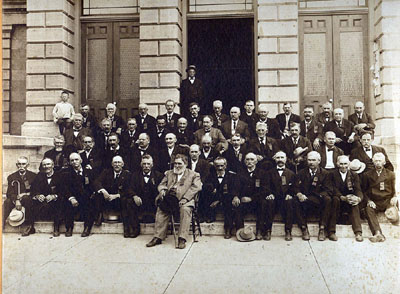Charlene Cole
Sandy Creek/Lacona Historian
Historian's Corner
May 30, 2015
Memorial Day, originally called Decoration Day, is a day of remembrance for those who have died in our nation's service. Memorial Day was officially proclaimed on 5 May 1868 by General John Logan, national commander of the Grand Army of the Republic and was first observed on 30 May 1868, when flowers were placed on the graves of Union and Confederate soldiers at Arlington National Cemetery. On May 5, 1868, Logan declared in General Order No. 11 that: The 30th of May, 1868, is designated for the purpose of strewing with flowers, or otherwise decorating the graves of comrades who died in defense of their country during the late rebellion, and whose bodies now lie in almost every city, village, and hamlet churchyard in the land. In this observance no form of ceremony is prescribed, but posts and comrades will in their own way arrange such fitting services and testimonials of respect as circumstances may permit. By 1890 it was recognized by all of the northern states. The South refused to acknowledge the day, honoring their dead on separate days until after World War I (when the holiday changed from honoring just those who died fighting in the Civil War to honoring Americans who died fighting in any war). The first state to officially recognize the holiday was New York in 1873.
|
 |
One of the customs in many cemeteries is that of orienting the graves on an east-west axis. The inscription on the headstone might face east or west; however many face west so that visitors are not standing on the grave to read the inscription. But inscriptions can be on all sides of a marker, so check the back and sides. If there is a foot-stone to the west of the grave, then it is obvious which direction the body was placed. The body is laid with its head to the east and feet to the west, so that it will rise up facing east.
Prior to and during the Civil War, most soldiers’ markers were nothing more than
rounded-at-the-top wooden boards with carved inscriptions. These were not durable
and had a life expectancy of only five years. Not until 1865, when more than 100,000
soldiers were buried in the national cemeteries, did the government give serious
consideration to abandoning the use of wooden markers. A seven-year debate arose
over whether the graves should be marked with marble or galvanized iron coated with
zinc. By 1873, marble had won out.
The Civil War-type marker (1873) was used in national cemeteries. For the known dead, markers were made of polished marble (or durable stone) four inches thick, ten inches wide, and twelve inches high above ground, and the tops were slightly rounded. The number of the grave, rank, name of soldier, and name of state were carved on the front in a sunken shield. These markers were furnished for the unmarked graves of eligible deceased soldiers of the Revolutionary War, the War of 1812, the Mexican War, and the Indian Campaigns. In 1879, Congress authorized furnishing stones for unmarked graves of veterans in private cemeteries and in 1899, the Spanish-American War Veterans markers were the same design as the Civil War markers, but the words "Spanish American War" appeared.
|
Charlene Cole
Sandy Creek/Lacona Historian
1992 Harwood Drive
Sandy Creek, NY 13145
315-387-5456 x7
office hours: Friday 9am to 2pm
www.sandycreeknyhistory.com |

